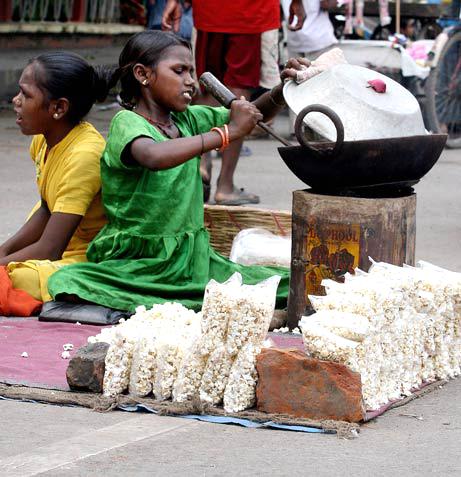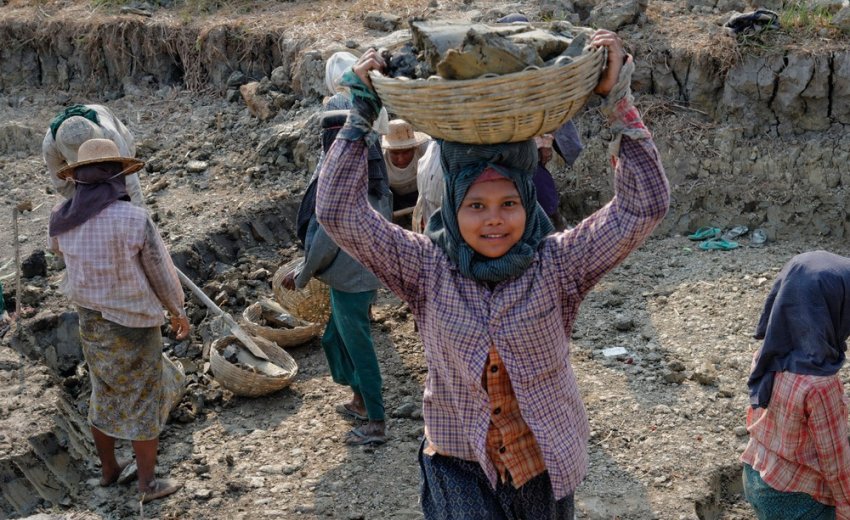BANGALORE, India — Rajeshwari spent her childhood trailing her mother on Bangalore's streets, helping her sift through roadside trash for recyclables. Now 15, she's still working, currently as a night dishwasher for a company catering wedding parties.
Like many of the tens of millions of child laborers in India—plenty of whose labor ends up in exports to the United States—she sees holding down a job less as a violation of her human rights than as a simple reality of life.
"I don't work because I want to. I have to," the pigtailed girl says without resentment.
Stamping out child labor is a tricky business for India's government. As officials try to modernize both India's economy and its image, they aim to cut back on a practice that much of the world sees as abhorrent. But in a nation where tens of millions of kids work, children's labor is not just a key source of financial support for families, it is legal.
The government over the last year and a half has put more jobs off-limits for kids, staged raids on factory sweatshops and pushed children nabbed at work back in school. But children's advocates say the campaign may not do much to better the lives of many kids.
"What is happening is making things worse for children," argued Kavita Ratna, a spokeswoman for The Concerned for Working Children, a non-profit group for child laborers in Bangalore, one of southern India's high-tech centers.

Under Indian law, children under 14 are free to work as long as the job isn't deemed "hazardous." At least 12.7 million do, according to government figures, and the United Nations and children's advocacy groups estimate the number is above 40 million. Across the country, children as young as 5 — working legally — collect fees at parking lots, sort recyclables, pick crops, pack boxes at factories and sell vegetables by the roadside and magazines in traffic. Many earn only pennies a day; others, older and more skilled, can earn the equivalent of $5 a day or more.
Problem for U.S. companies
That is an ongoing problem for U.S. companies that manufacture items in India. Clothing retailer Gap discovered late last year that children in a New Delhi factory were embroidering blouses intended for sale at GapKids stores in the United States and Europe.
It has since withdrawn the garments from its shops, suspended orders from factories found to be using child labor and promised the now out-of-work children a variety of help, including their jobs back once they reach legitimate working age. But sweatshops continue to spring up around the country.
Other U.S. companies have faced similar concerns in the production of clothes, handicrafts, sporting goods, jewelry, decorative stone, carpets and agricultural products, among other exports from India.
Since the end of 2006, kids under 14 also have been officially banned from many jobs they have historically held — cleaning hotel rooms, serving food in restaurants, working as maids in homes — though unofficially many remain at work. The government also has set up programs in 250 districts around the country aimed at getting working kids back in schools.
The effort "is working," said Harjot Kaur, director of child labor in India's Ministry of Labor and Employment, who predicts the number of child laborers will be way down by the next census in 2011.
But child advocacy groups say raids on factory sweatshops, where children labor illegally, often end with kids left in legal limbo in state "observation homes," or tossed into decrepit state schools.
The raids also have driven child labor from factory front rooms, where it is easy to monitor, into hidden recesses of workplaces, where the potential for abuse is greater, the advocates say. And kids plucked from jobs and reunited with the families that sent them off to work in the first place often find themselves quickly back in another job, or suffering abuse and hunger at home.
In India today, "if you call yourself a working child, people pounce on you and drag you to the nearest school. Child labor has become a dirty word," Ratna said. "No one wants to admit there are still working children."
She recounts the story of a midnight raid on a silver factory in Bangalore some years back where 150 child workers were bundled onto a train back to their home state in northeast India. Many, who shared no common language with their rescuers, were terrified by the unexpected invasion or were traumatically separated from older working siblings left behind at the factory during the raid. Many did not want to return home.
A year later, when a Bangalore professor went to check on the children, she could find none of them in their home villages.
"The parents said, 'Why did you bring them back? We sent them there because we don't have food to eat,' " Ratna remembers the woman recounting. Maoist rebels in the region also were a threat to the kids if they remained there, the parents said, insisting that the children were safer in Bangalore.
Ratna's group — which takes the practical view that child labor isn't going to disappear any time soon — argues that the most effective way to help child workers is not to force them out of their jobs but to protect and empower them while there.
The advocacy group over the past 17 years has helped working children set up or strengthen informal networks that help them share information, protect each other and advocate for better conditions.
For instance, Rajeshwari, the vice president of Bhima Sangha, a working children's union created by Ratna's group, said local cells of 10 or 12 working children have helped provide financial and emotional support to children forced out of jobs or abused in them, as well as other practical help.
In some cases, children's groups have pressed employers to provide medical care for children injured at work, or passed information to authorities about underage maids who are abused. After a Bangalore hotel fire killed three child workers, children's union members wrote a report for the state government that may have contributed to children under 14 being banned from hotel work, according to The Concerned for Working Children.
'We feel proud'
"Earlier most people would not listen to us. Now they listen," said Rajeshwari, whose new night job allows her to attend school during the day. "We got to know what our rights are. We feel proud."
Ratna said her organization's efforts simply formalize and expand "very sophisticated systems" many working children have already created to help each other.
Her group tries to make the lives of child laborers easier by experimenting with counterintuitive ideas like helping them get access to small-business loans and teaching them negotiation and business skills. It has also worked to find ways to help children balance work with staying in school.
Reducing the number of child laborers in India, child advocates say, will require helping parents find better-paying jobs that let them support their families without children's salaries and improving the country's public schools.
Until those problems are resolved, "you can be outraged as much as you want" by child labor, Ratna said. "But what does it do for the child?"
-By Laurie Goering
Tribune correspondent
[email protected]
Copyright © 2008, Chicago Tribune
